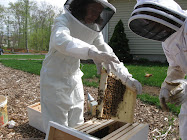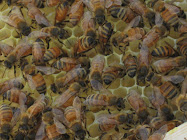Support local farmers' efforts to become part of the Slow Food Nation movement. Two local Providence Restaurant owners / chefs that invest in local foods Farmstead and New Rivers are holding The Rhode Island Aquaculture Dinner on Sunday, March 30 at New Rivers. The cost for the five-course dinner is $75 and includes mollusks, bivalves and more. The money from the dinner sill send Rhode Island farmers to the Slow Food Nation show in San Francisco. Call New Rivers at 401-751-0350.
"Slow Food Nation inspires and empowers Americans to build a food system that is good, clean and fair.The world's most pressing questions regarding health, culture, the environment, education, social justice and the global economy are all deeply connected to the food we eat and how it is produced. Slow Food Nation is an event at the center of a movement with national impact and global implications. It will engage tens of thousands of attendees in learning how everyday choices affect our wellbeing, our culture and the health of the planet. The event will be held from August 29 to September 1, 2008 in San Francisco, and will bring hundreds of farmers and food artisans from across the country to present an extraordinary range of foods and preparation techniques. It will offer activities for all ages, including food, music, talks, forums, workshops, films and exhibits, all highlighting food that supports an agricultural system that is good, clean and fair."
CSA's
Have you heard of CSA's? No, not CFL's the light bulbs, not CPA's the number crunchers ... CSA Community Supported Agriculture. You basically "sign-up" with a local farm to buy a "share" of the local food grown at that farm. This way you are supporting local farms and living a greener lifestyle by purchasing local foods as they are ready in your local area -- as oppossed to paying for food that's been motored to your grocery store all the way from South America. To connect to a local farm near you go to www.localharvest.org . If you are in the greater Providence, Rhode Island area, or close to Little Compton, Rhode Island there is a wonderful organic and I.P.M. CSA that is worth checking out. www.wishingstonefarm.com You can pick up your "share" from Wishing Stone in Providence or in Little Compton right at the farm (which incidentally is just down the street from our tiny summer place). Wishing Stone allows you to pick what you want from what they have available as opposed to giving you a pre-packed box or bag. Different farms handle distribution differently. Don't delay though, because shares sell out.
Phosphates
Phosphates. Just what are they? Have you seen the labeling on cleaning products boldly claiming "contains no phosphates". Well, that got me to thinking, What on earth are they? Why are they bad for the environment? and What HAS phosphates IN them? Well, the short answer is:
- A) Dishwasher Detergent is the most common place you will find phosphates in your home. FYI: After a few trials, the best most effective phosphate-free dishwasher detergent I've used is Seventh Generation.
- B) Phosphates basically act like a fertilizer that when they enter water tables, rivers, lakes ... etc. they over produce algae that rob the water of all of the oxygen then of course fish and other aquatic organisms die.
- C) It's serious enough that when the government recognized the problems that phosphates were causing, local governments started putting limits on the amount of phosphates allowed in products. In Washington State for example, by 2010 phosphate levels cannot exceed 0.5 percent.
But, it's more complicated than that. About a month ago I did some research online and copied a few articles to a file ... but regretably didn't record where I got them from. So, sorry I'm not to be able to reference these. However, for what it's worth, here are more in depth explainations:
From Article 1:
"Phosphates enter waterways from human and animal waste, phosphorus rich bedrock, laundry, cleaning, industrial effluents, and fertilizer runoff. These phosphates become detrimental when they over fertilize aquatic plants and cause stepped up eutrophication.
Eutrophication is the natural aging process of a body of water such as a bay or lake. This process results from the increase of nutrients within the body of water which, in turn, create plant growth. The plants die more quickly than they can be decomposed. This dead plant matter builds up and together with sediment entering the water, fills in the bed of the bay or lake making it more shallow. Normally this process takes thousands of years.
Cultural eutrophication is an unnatural speeding up of this process because of man's addition of phosphates, nitrogen, and sediment to the water. Bodies of water are being aged at a much faster rate than geological forces can create new ones.
In testing for cultural eutrophication, one would expect to find an algal bloom or scum on the water accompanied by a fishy smell to the water and a low dissolved oxygen content. Do not expect to find a high phosphate reading if the algae is already blooming, as the phosphates will already be in the algae, not in the water. The algae bloom should start where running water enters the lake or bay, so test the water before the area where the bloom begins for high phosphate and nitrate levels.
Monitors should be aware that there are different kinds of phosphates in the water, but a total phosphate-phosphorous reading is all that is needed to calculate the water quality. Use the chart below to rate your water sample:
How phosphorous affects aquatic life
If too much phosphate is present in the water the algae and weeds will grow rapidly, may choke the waterway, and use up large amounts of precious oxygen (in the absence of photosynthesis and as the algae and plants die and are consumed by aerobic bacteria.) The result may be the death of many fish and aquatic organisms.
Environmental Impact: Rainfall can cause varying amounts of phosphates to wash from farm soils into nearby waterways. Phosphate will stimulate the growth of plankton and aquatic plants which provide food for fish. This may cause an increase in the fish population and improve the overall water quality. However, if an excess of phosphate enters the waterway, algae and aquatic plants will grow wildly, choke up the waterway and use up large amounts of oxygen. This condition is known as eutrophication or over-fertilization of receiving waters. This rapid growth of aquatic vegetation eventually dies and as it decays it uses up oxygen. This process in turn causes the death of aquatic life because of the lowering of dissolved oxygen levels. Phosphates are not toxic to people or animals unless they are present in very high levels. Digestive problems could occur from extremely high levels of phosphate."
Eutrophication is the natural aging process of a body of water such as a bay or lake. This process results from the increase of nutrients within the body of water which, in turn, create plant growth. The plants die more quickly than they can be decomposed. This dead plant matter builds up and together with sediment entering the water, fills in the bed of the bay or lake making it more shallow. Normally this process takes thousands of years.
Cultural eutrophication is an unnatural speeding up of this process because of man's addition of phosphates, nitrogen, and sediment to the water. Bodies of water are being aged at a much faster rate than geological forces can create new ones.
In testing for cultural eutrophication, one would expect to find an algal bloom or scum on the water accompanied by a fishy smell to the water and a low dissolved oxygen content. Do not expect to find a high phosphate reading if the algae is already blooming, as the phosphates will already be in the algae, not in the water. The algae bloom should start where running water enters the lake or bay, so test the water before the area where the bloom begins for high phosphate and nitrate levels.
Monitors should be aware that there are different kinds of phosphates in the water, but a total phosphate-phosphorous reading is all that is needed to calculate the water quality. Use the chart below to rate your water sample:
How phosphorous affects aquatic life
If too much phosphate is present in the water the algae and weeds will grow rapidly, may choke the waterway, and use up large amounts of precious oxygen (in the absence of photosynthesis and as the algae and plants die and are consumed by aerobic bacteria.) The result may be the death of many fish and aquatic organisms.
Environmental Impact: Rainfall can cause varying amounts of phosphates to wash from farm soils into nearby waterways. Phosphate will stimulate the growth of plankton and aquatic plants which provide food for fish. This may cause an increase in the fish population and improve the overall water quality. However, if an excess of phosphate enters the waterway, algae and aquatic plants will grow wildly, choke up the waterway and use up large amounts of oxygen. This condition is known as eutrophication or over-fertilization of receiving waters. This rapid growth of aquatic vegetation eventually dies and as it decays it uses up oxygen. This process in turn causes the death of aquatic life because of the lowering of dissolved oxygen levels. Phosphates are not toxic to people or animals unless they are present in very high levels. Digestive problems could occur from extremely high levels of phosphate."
From Article 2:
"Back in the 1970s, the U.S. government recognized the problem of phosphorus pollution -- it can cause massive algal blooms in waterways that screw with ecosystems by robbing the water and aquatic life of all-important oxygen -- and started trying to come up with alternatives. Meanwhile, states and localities became more and more aware of the undesirable effects of phosphorus and began acting on their own to limit or restrict its use in laundry detergents, the first places being five cities in Illinois in 1971. (Way to go, Illinoisans!) By the 1990s, enough states and localities had limited or restricted laundry-detergent phosphates that detergent companies saw the writing on the machine and decided to voluntarily phase them out in all domestic formulations, which was done by the mid-1990s.
The main reason dishwashing-detergent phosphates didn't get the same treatment was that the best alternatives, enzymes, were neither common nor cheap even as late as the early '90s. There was also the influence of heavy lobbying by detergent makers and phosphate cheerleaders to keep them in. And so phosphates remain in many detergents at varying levels, even though they don't need to be there.
There are plenty of eco-friendly, phosphate-free alternatives that wash dishes just as well or better than phosphate-laden ones. And you probably won't be surprised to learn that mainstream, big-name detergents have lots of other suspect ingredients that are derived from petroleum and aren't so environmentally benign, a main one being artificial fragrances. So it's best to use one of the eco-brands anyway, and any eco-brand worth its eco-label will be phosphate- and chlorine-free.
Some states and localities are starting to severely limit or ban phosphates in dishwasher detergent too. My spiffy home state of Washington signed new rules into law this year that will keep the phosphorus content in dishwashing detergent to 0.5 percent beginning in 2010. It's a significant cut, since detergents now contain up to 9 percent."
The main reason dishwashing-detergent phosphates didn't get the same treatment was that the best alternatives, enzymes, were neither common nor cheap even as late as the early '90s. There was also the influence of heavy lobbying by detergent makers and phosphate cheerleaders to keep them in. And so phosphates remain in many detergents at varying levels, even though they don't need to be there.
There are plenty of eco-friendly, phosphate-free alternatives that wash dishes just as well or better than phosphate-laden ones. And you probably won't be surprised to learn that mainstream, big-name detergents have lots of other suspect ingredients that are derived from petroleum and aren't so environmentally benign, a main one being artificial fragrances. So it's best to use one of the eco-brands anyway, and any eco-brand worth its eco-label will be phosphate- and chlorine-free.
Some states and localities are starting to severely limit or ban phosphates in dishwasher detergent too. My spiffy home state of Washington signed new rules into law this year that will keep the phosphorus content in dishwashing detergent to 0.5 percent beginning in 2010. It's a significant cut, since detergents now contain up to 9 percent."
Hope you find this interesting and informative. Enjoy!






























No comments:
Post a Comment